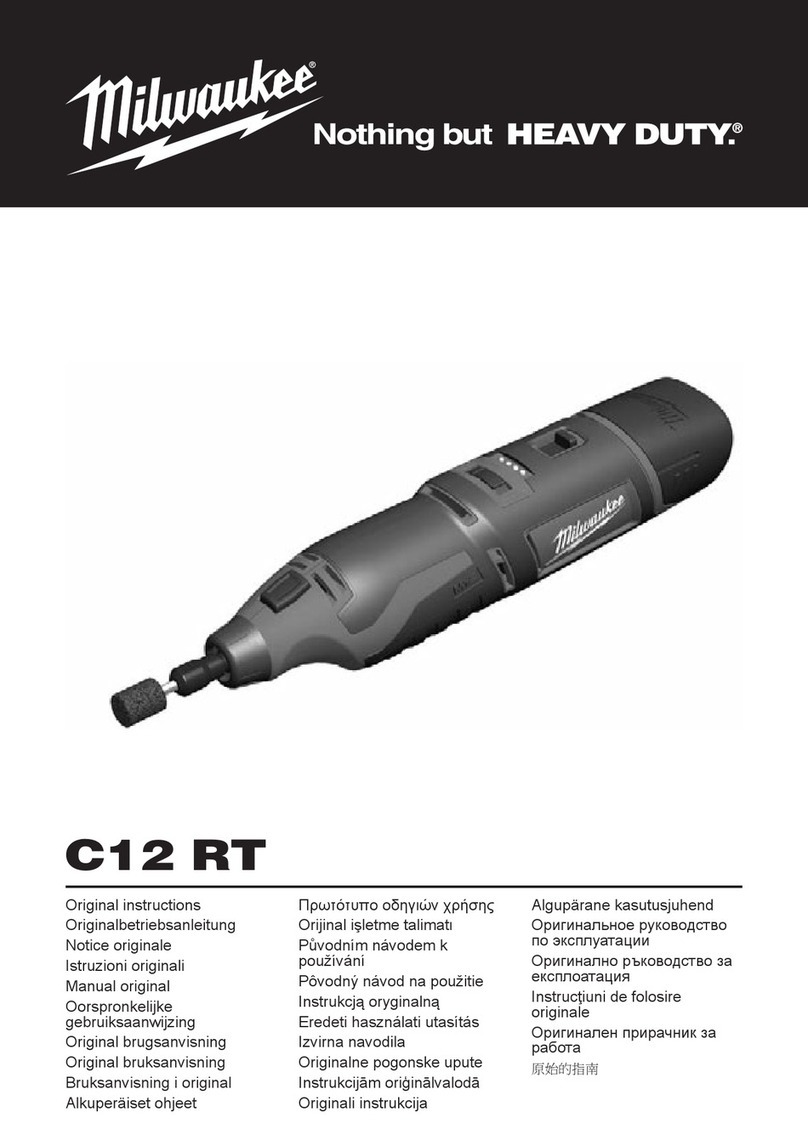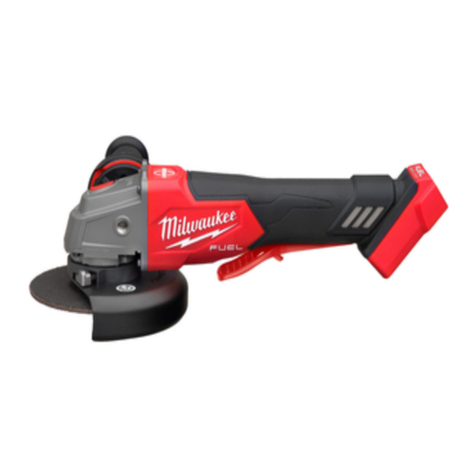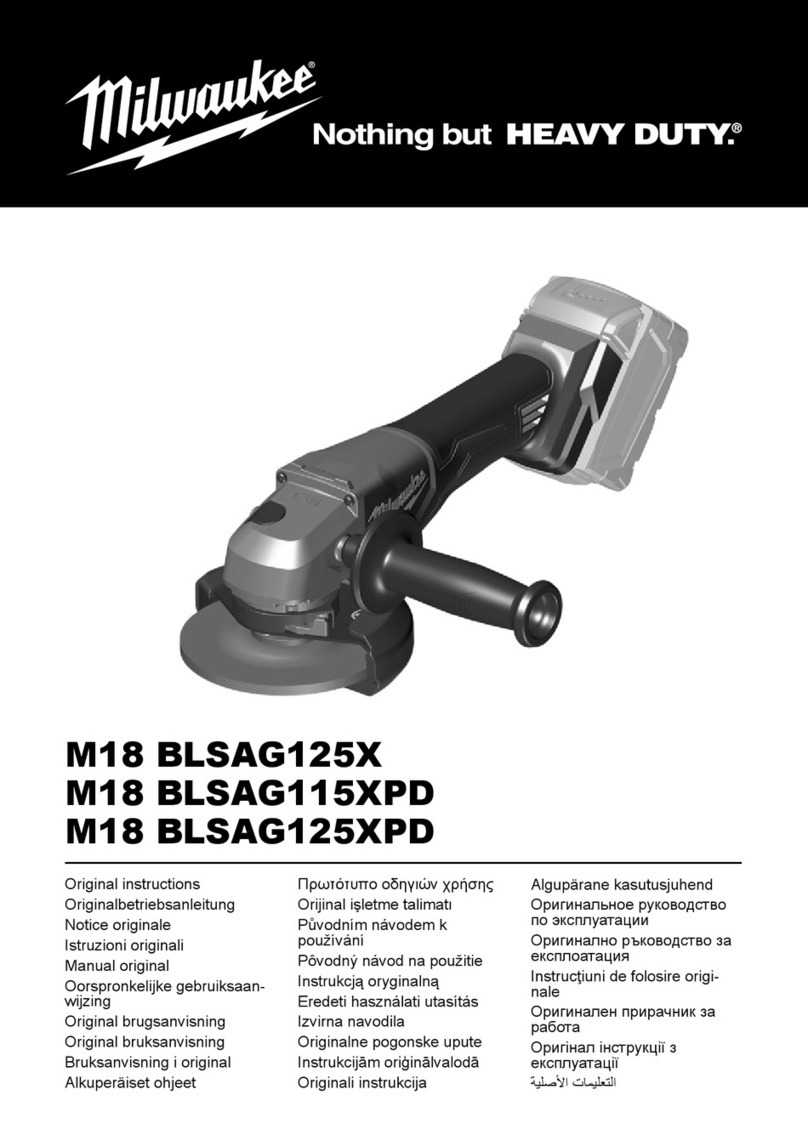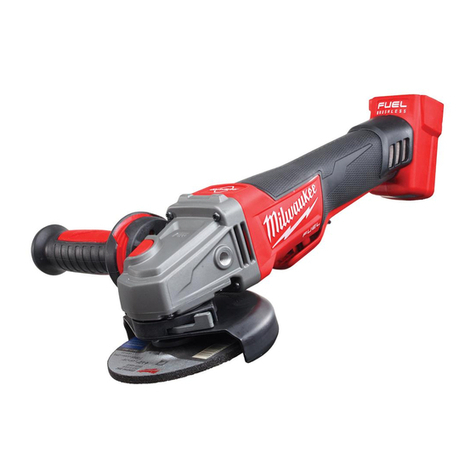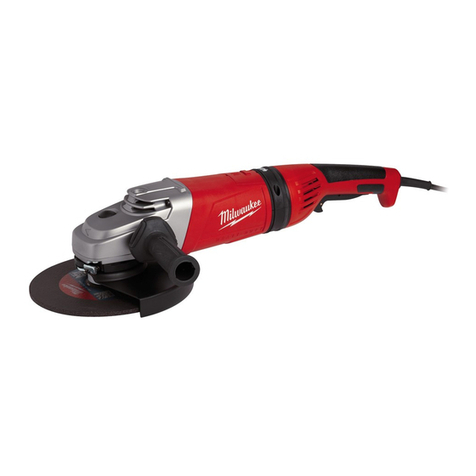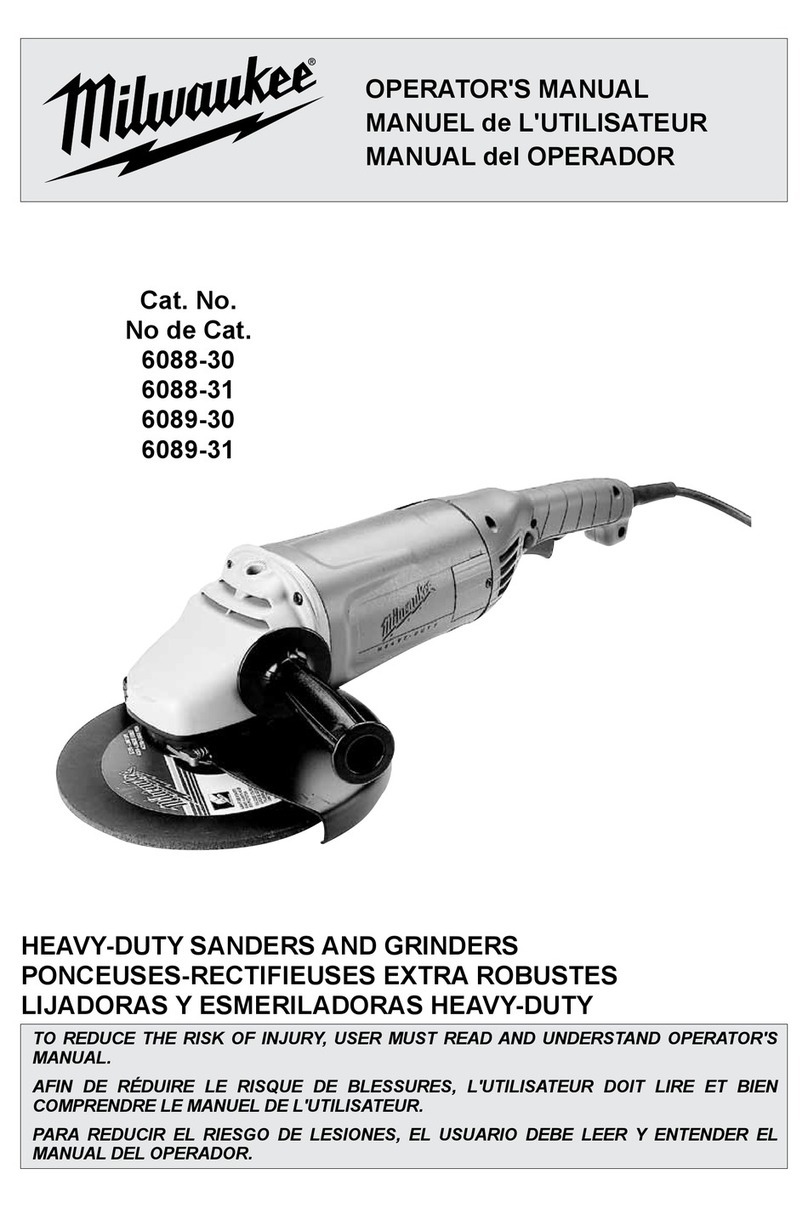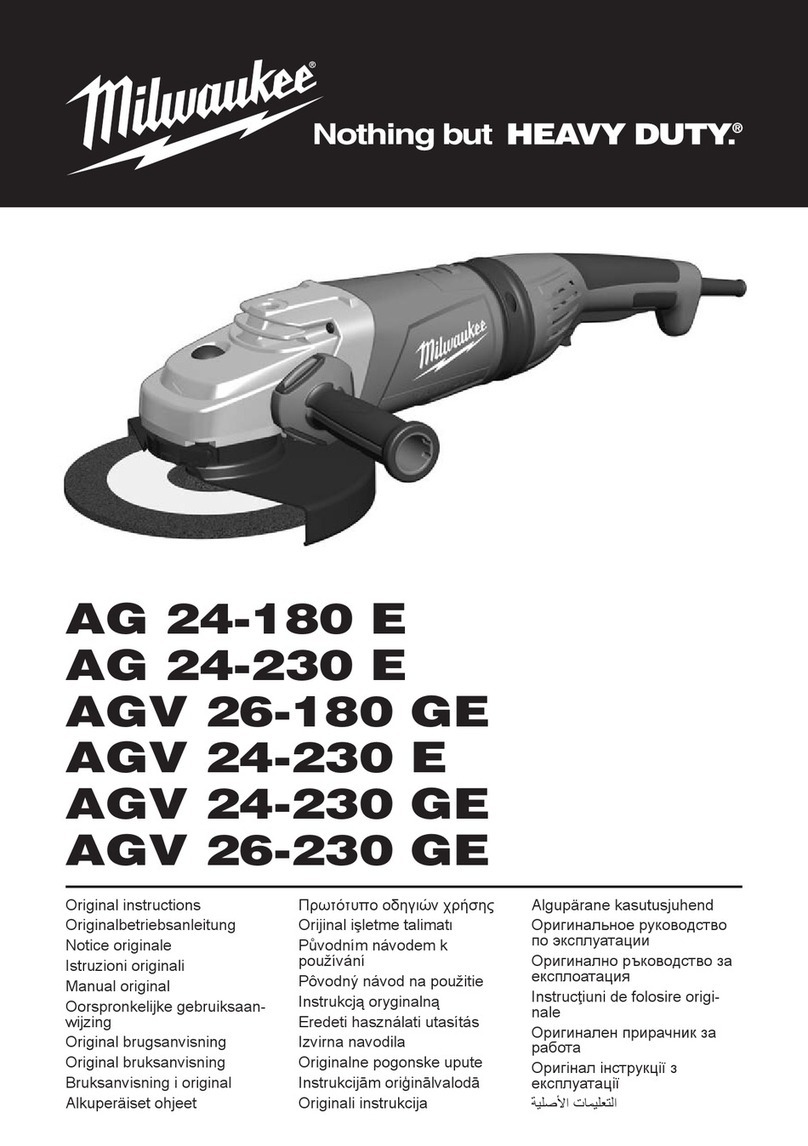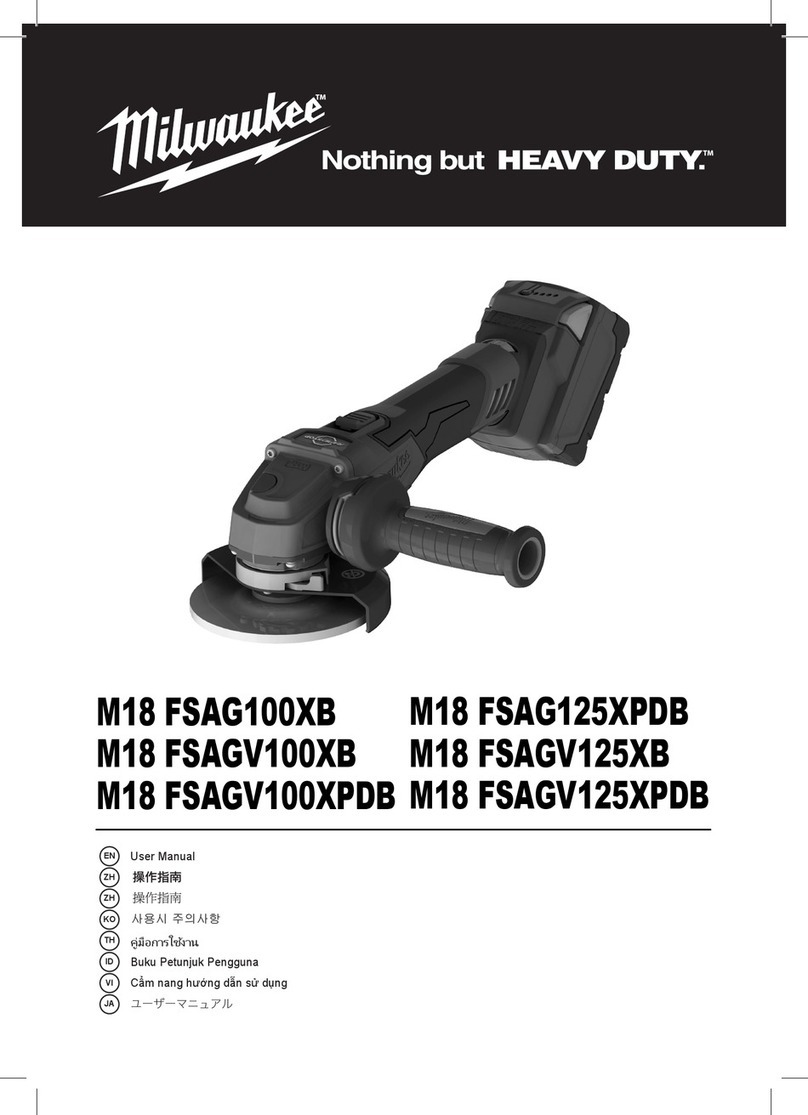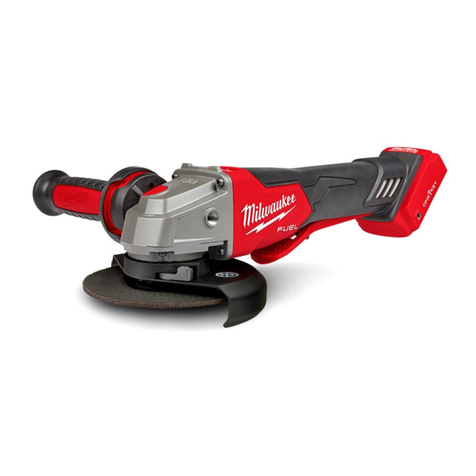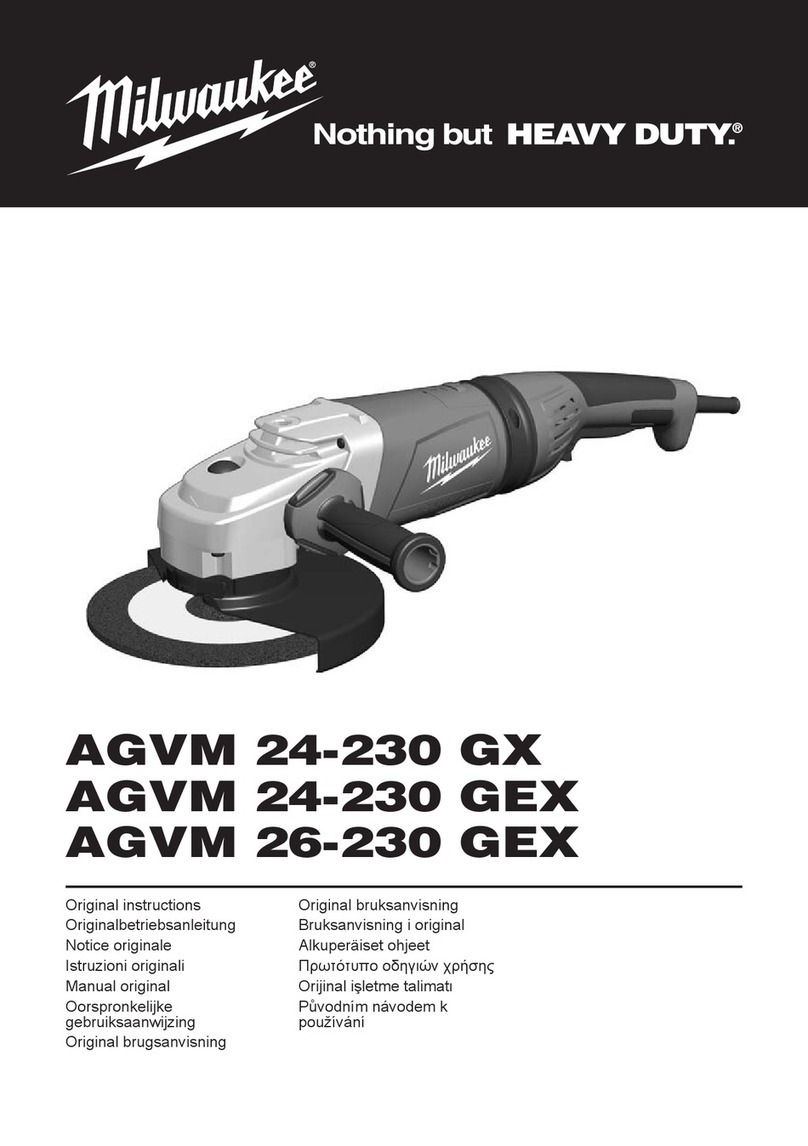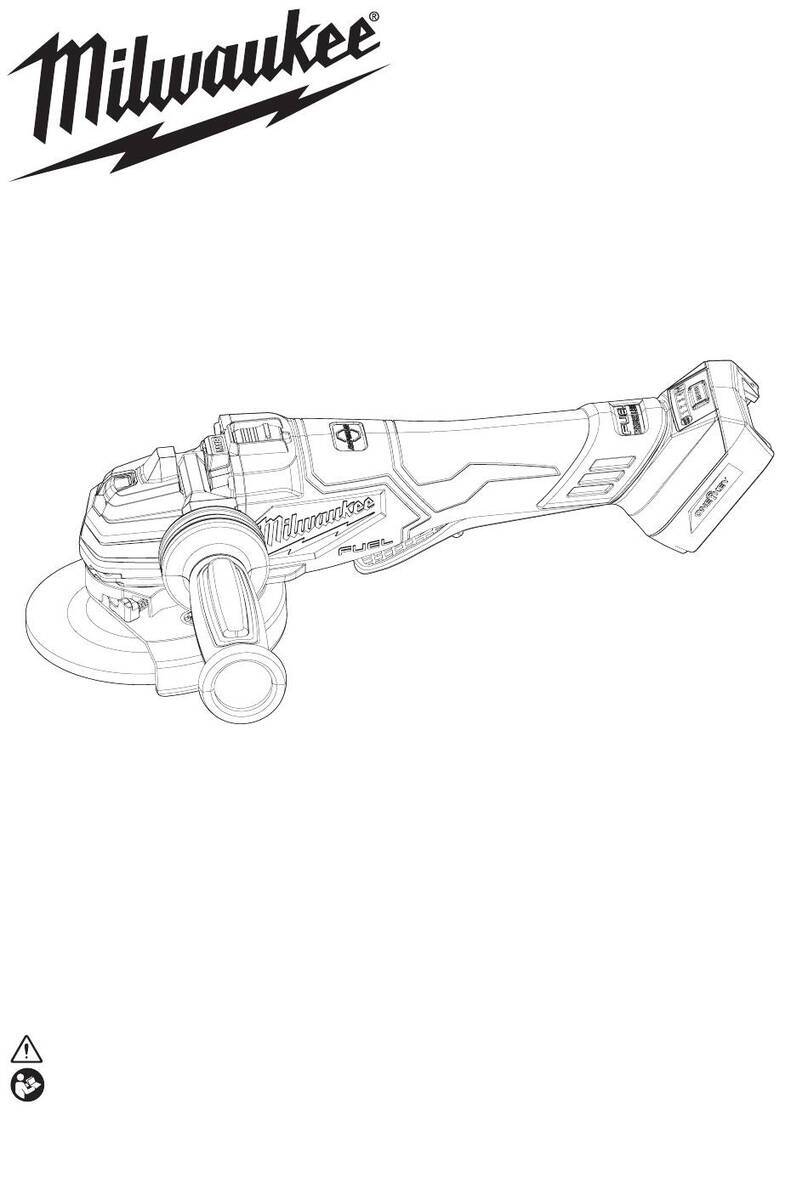23
GENERAL POWER TOOL
SAFETY WARNINGS
WARNING
Read all safety warnings, instruc-
tions, illustrations and specifica-
tions provided with this power tool. Failure to
follow all instructions listed below may result in
electric shock, fire and/or serious injury. Save all
warnings and instructions for future reference.
The term "power tool" in the warnings refers to your
mains-operated(corded)powertoolorbattery-oper-
ated (cordless) power tool.
WORK AREA SAFETY
•Keep work area clean and well lit. Cluttered or dark
areas invite accidents.
•Do not operate power tools in explosive atmo-
spheres, such as in the presence of flammable
liquids, gases or dust. Power tools create sparks
which may ignite the dust or fumes.
•Keep children and bystanders away while operat-
ing a power tool. Distractionscancauseyoutolose
control.
ELECTRICAL SAFETY
•Power tool plugs must match the outlet. Never
modify the plug in any way. Do not use any
adapter plugs with earthed (grounded) power
tools. Unmodified plugs and matching outlets will
reduce risk of electric shock.
•Avoid body contact with earthed or grounded
surfaces, such as pipes, radiators, ranges and
refrigerators. There is an increased risk of electric
shock if your body is earthed or grounded.
•Do not expose power tools to rain or wet condi-
tions. Water entering a power tool will increase the
risk of electric shock.
•Do not abuse the cord. Never use the cord for
carrying, pulling or unplugging the power tool.
Keep cord away from heat, oil, sharp edges or
movingparts.Damagedorentangledcords increase
the risk of electric shock.
•When operating a power tool outdoors, use an
extension cord suitable for outdoor use. Use of
a cord suitable for outdoor use reduces the risk of
electric shock.
•If operating a power tool in a damp location is
unavoidable, use a groundfault circuit interrupter
(GFCI) protected supply. Use of an GFCI reduces
the risk of electric shock.
PERSONAL SAFETY
•Stay alert, watch what you are doing and use
common sense when operating a power tool. Do
not use a power tool while you are tired or under
the influence of drugs, alcohol or medication. A
moment of inattention while operating power tools
may result in serious personal injury.
•Use personal protective equipment. Always wear
eye protection. Protectiveequipmentsuch as a dust
mask, non-skid safety shoes, hard hat or hearing
protectionusedforappropriate conditions will reduce
personal injuries.
•Prevent unintentional starting. Ensure the switch
is in the off-position before connecting to power
source and/or battery pack,picking up orcarrying
the tool. Carryingpowertoolswithyourfingeronthe
switchorenergizingpowertoolsthathavetheswitch
on invites accidents.
•Remove any adjusting key or wrench before
turning the power tool on. A wrench or a key left
attachedtoa rotating part ofthepower tool may result
in personal injury.
•Do not overreach. Keep proper footing and bal-
ance at all times. This enables better control of the
power tool in unexpected situations.
•Dress properly. Do not wear loose clothing or
jewelry. Keep your hair and clothing away from
moving parts. Loose clothes, jewelry or long hair
can be caught in moving parts.
•If devices are provided for the connection of dust
extraction and collection facilities, ensure these
are connected and properly used. Use of dust
collection can reduce dust-related hazards.
•Do not let familiarity gained from frequent use
of tools allow you to become complacent and
ignore tool safety principles. A careless action
cancausesevereinjurywithinafractionofa second.
POWER TOOL USE AND CARE
•Do not force the power tool. Use the correct
power tool for your application. Thecorrectpower
tool will do the job better and safer at the rate for
which it was designed.
•Donotusethepowertooliftheswitchdoesnotturn
iton and off. Anypower tool thatcannotbe controlled
with the switch is dangerous and must be repaired.
•Disconnect the plug from the power source and/
or remove the battery pack, if detachable, from
the power tool before making any adjustments,
changing accessories, or storing power tools.
Such preventive safety measures reduce the risk of
starting the power tool accidentally.
•Store idle power tools out of the reach of children
and do not allow persons unfamiliar with the
power tool or these instructions to operate the
power tool. Powertoolsaredangerousin the hands
of untrained users.
•Maintain power tools and accessories. Check for
misalignment or binding of moving parts, break-
age of parts and any other condition that may
affect the power tool’s operation. If damaged,
have the power tool repaired before use. Many
accidents are caused by poorly maintained power
tools.
•Keep cutting tools sharp and clean. Properly
maintainedcuttingtoolswithsharpcuttingedgesare
less likely to bind and are easier to control.
•Use the power tool, accessories and tool bits etc.
in accordance with these instructions, taking into
account the working conditions and the work to
be performed. Use of the power tool for operations
differentfrom those intended couldresultina hazard-
ous situation.
•Keep handles and grasping surfaces dry, clean
and free from oil and grease. Slippery handles
and grasping surfaces do not allow for safe handling
and control of the tool in unexpected situations.
SERVICE
•Have your power tool serviced by a qualified
repair person using only identical replacement
parts. This will ensure that the safety of the power
tool is maintained.
SPECIFIC SAFETY RULES FOR
STRAIGHT GRINDER
SafetyWarningsCommonforGrindingOperations:
•This power tool is intended to function as a
grinder. Read all safety warnings, instructions,
illustrations and specifications provided with
this power tool. Failure to follow all instructions
listed below may result in electric shock, fire and/or
serious injury.
•Operations such as sanding, wire brushing,
polishing or cutting-off are not recommended to
be performed with this power tool. Operations for
which the power tool was not designed may create
a hazard and cause personal injury.
•Do not use accessories which are not specifically
designedandrecommended by the toolmanufac-
turer. Just because the accessory can be attached
to your power tool, it does not assure safe operation.
•The rated speed of the accessory must be at
least equal to the maximum speed marked on
the power tool.Accessories running faster than their
rated speed can break and fly apart.
•
The outside diameter and the thickness of your
accessory must be within the capacity rating of
your power tool. Incorrectly sized accessories can-
not be adequately guarded or controlled.
•Threaded mounting of accessories must match
the grinder spindle thread. For accessories
mounted by flanges, the arbour hole of the ac-
cessory must fit the locating diameter of the
flange.Accessories that do not match the mounting
hardware of the power tool will run out of balance,
vibrate excessively and may cause loss of control.
•Do not use a damaged accessory. Before each
use inspect the accessory such as abrasive
wheels for chips and cracks, backing pad for
cracks, tear or excess wear, wire brush for loose
or cracked wires. If power tool or accessory is
dropped, inspect for damage or install an undam-
aged accessory. After inspecting and installing
an accessory, position yourself and bystanders
away from the planeof the rotating accessoryand
run the power tool at maximum no-load speed
for one minute. Damagedaccessorieswill normally
break apart during this test time.
•Wear personal protective equipment. Depending
on application, use face shield, safety goggles or
safety glasses. As appropriate, wear dust mask,
hearing protectors, gloves and workshop apron
capable of stopping small abrasive or workpiece
fragments. The eye protection must be capable of
stopping flying debris generated by various opera-
tions. The dust mask or respirator must be capable
of filtrating particles generated by your operation.
Prolonged exposure to high intensity noise may
cause hearing loss.
•Keep bystanders a safe distance away from
work area. Anyone entering the work area must
wear personal protective equipment. Fragments
of workpiece or of a broken accessory may fly away
andcause injury beyondimmediateareaof operation.
•Hold the power tool by insulated gripping sur-
faces only, when performing an operation where
the cutting tool may contact hidden wiring or its
own cord. Contact with a "live" wire may also make
exposedmetalparts of the power tool"live"andcould
give the operator an electric shock.
•Position the cord clear of the spinning accessory.
If you lose control, the cord may be cut or snagged
andyourhandor arm may be pulled into the spinning
accessory.
•Never lay the power tool down until the acces-
sory has come to a complete stop. The spinning
accessory may grab the surface and pull the power
tool out of your control.
•Do not run the power tool while carrying it at your
side.Accidental contactwith the spinning accessory
could snag your clothing, pulling the accessory into
your body.
•Regularly clean the power tool’s air vents. The
motor’s fan will draw the dust inside the housing
andexcessiveaccumulationofpowderedmetalmay
cause electrical hazards.
•Do not operate the power tool near flammable
materials. Sparks could ignite these materials.
•Do not use accessories that require liquid cool-
ants. Using water or other liquid coolants may result
in electrocution or shock.
Kickback and Related Warnings
Kickbackisa sudden reactiontoapinched or snagged
rotatingwheel,backing pad, brush or anyotheracces-
sory. Pinching or snagging causes rapid stalling of the
rotating accessory which in turn causes the uncon-
trolledpowertoolto be forced in the direction opposite
of the accessory’s rotation at the point of the binding.
For example, if an abrasive wheel is snagged or
pinched by the workpiece, the edge of the wheel that
isenteringintothepinchpointcandiginto the surface
of the material causing the wheel to climb out or kick
out. The wheel may either jump toward or away from
the operator, depending on direction of the wheel’s
movement at the point of pinching. Abrasive wheels
may also break under these conditions.
Kickback is the result of power tool misuse and/or in-
correctoperatingprocedures or conditions and canbe
avoided by taking proper precautions as given below.
•Maintain a firm grip on the power tool and posi-
tion your body and arm to allow you to resist
kickback forces. Always use auxiliary handle, if
provided, for maximum control over kickback or
torque reaction during start-up. The operator can
control torque reactions or kickback forces, if proper
precautions are taken.
•Never place your hand near the rotating acces-
sory. Accessory may kickback over your hand.
•Do not position your body in the area where
power tool will move if kickback occurs. Kickback
willpropelthetoolin direction opposite to the wheel’s
movement at the point of snagging.
•Use special care when working corners, sharp
edges etc. Avoid bouncing and snagging the ac-
cessory. Corners, sharp edges or bouncing have a
tendency to snag the rotating accessory and cause
loss of control or kickback.
•Do not attach a saw chain woodcarving blade or
toothed saw blade. Such blades create frequent
kickback and loss of control.
Safety Warnings Specific for Grinding Operations:
•Use only wheel types that are recommended for
your power tool and the specific guard designed
for the selected wheel. Wheelsforwhichthepower
toolwasnotdesigned cannot be adequately guarded
and are unsafe.
•The grinding surface of centre depressed wheels
must be mounted belowthe plane of theguard lip.
An improperly mounted wheel that projects through
the plane of the guard lip cannot be adequately
protected.
•Theguard must be securelyattached to the power
tool and positioned for maximum safety, so the
least amount of wheel is exposed towards the
operator. The guard helps to protect the operator
from broken wheel fragments, accidental contact
with wheel and sparks that could ignite clothing.
•Wheels must be used only for recommended
applications. For example: do not grind with the
side of cut-off wheel. Abrasive cut-off wheels are

